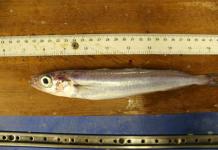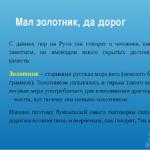Merlang is a schooling deep-sea fish, a distant relative of the cold-loving cod, widespread throughout the Black Sea. It feels at ease in places with great depths - up to 150 meters and cold water - up to 10 degrees. Like any Black Sea fish, it has a number of nicknames: whiting, mizgir, pebble, haddock. Without further ado, although this is a misnomer, in our area this fish is simply called haddock.
The fishing of whiting by fishermen is more random than meaningful. Amateur fishermen, on the contrary, always greet news of the presence of whiting, especially of decent size, with great enthusiasm and sometimes without hesitation they switch from catching one type of fish to another, abandon their homes and rush to catch whiting ().
The length of this fish most often does not exceed 25 centimeters and 300 grams of weight, but, despite its not very impressive size, whiting is rightfully considered quite worthy of being caught purposefully. Moreover, he is distinguished by a certain fearlessness: even when dolphins approach, prowling everywhere in search of horse mackerel, the school rarely moves or leaves its favorite places.
When to catch and where to look for whiting
Whiting does not like calf tenderness: warm water and shallow waters. As a result, this fish is caught year-round in the bottom layer at significant depths with almost icy water. Schools of whiting occupy vast territories and are found in such areas from morning until midnight without any breaks for lunch.
Most whiting fishing is done from boats at sea, although the possibility of active fishing from the shore in early spring cannot be ruled out. After prolonged winter storms that disrupt the natural directions of currents, whiting en masse approaches the coast, migrating for cool water.
Tackle for fishing whiting
The characteristics of the life cycle of whiting and its habitat directly determine the type of gear for catching it. Whiting sticks to deep areas of the sea, so it is most effective to use bottom gear to catch this fish ().
A spinning rod intended for fishing is equipped with powerful inertial or inertia-free reel models with a spool capacity of at least 150 meters, strong colorless fishing line - 0.16-0.22 millimeters, one bead, a carabiner with a swivel and a tyrant. Since there is no urgent need for a long rod, a three-meter heavy rod will do just fine.
Whiting bait
Bait and bait are not needed to catch this sea fish, since delivering them to the depth of interest is very problematic. The whiting has a voracious appetite, and it is quite difficult to tame it. He is equally eager to grab hooks, whether they are baited or completely bare.
Of course, as bait you can use fresh or boiled shrimp, pieces of squid and even lard, lovingly prepared for you to snack on by your family members, but all this is irrational. Why waste such precious bait? Better leave it for a more suitable occasion.
In our case, the most effective bait is the meat of any fish you catch along the way, cut into slices. It turns out that whiting are cannibals, and if they happily eat individuals of their own species, what can we say about the young of other fish ().
Whiting fishing technique
Having discovered a school of whiting, the boat must be anchored. Otherwise, unnoticed by you, your watercraft will slowly drift under the influence of wind and current, which, in the end, can lead to the loss of a place where fish accumulate.
The whiting bite is not very noticeable; on the rod it is observed as a weak twitching of the tip downwards, and on the fishing line - as a gentle tapping. Although the bites of this fish are inconspicuous, they are reliable. Sometimes they are not even expected: the next time the tyrant lifts off the ground, the curious whiting often catches itself on the hooks.
Fishing for this fish does not cause any particular difficulties, but it requires a certain skill and strength, because lifting whiting, and not just one, but five of them with a total weight of 1.5-2.0 kilograms from a depth of 80 meters is not an easy task.
Gastronomic features of whiting
It is important for all fishermen who are interested in whiting fishing to remember one thing: caught whiting cannot be stored for a long time and spoils very quickly. If handled carelessly, fish meat decomposes, turning into a gel-like mass with an unpleasant odor.
To reduce the risk of catch loss, two simple methods are used. First: several half-liter plastic bottles with pre-frozen water are thrown into the bottom of the buckets with fish. Second: they use baskets woven from twigs, periodically dipping them into sea water.
As for the taste properties of whiting: its meat is distinguished by its extraordinary whiteness and layering, elastic, sweetish and so tender that it is advisable to cook it freshly caught. The most ideal and exquisite dishes made from whiting are cutlets () and pate prepared with caviar, liver and milk ().
Catching Black Sea whiting is a very exciting, interesting and exciting process, I would even say, sporty in its own way, which will certainly appeal to any fisherman and will leave a lot of indelible impressions for a lifetime.
What is whiting fish? Not everyone knows that blue whiting is hidden under this name. This fish is also called Black Sea cod. For a long time it was considered a second-class product. In everyday life, blue whiting even received the name “cat fish”, as it was often used to feed domestic animals. Housewives rarely prepare dishes from whiting. However, this fish is healthy and nutritious. If you follow all the rules for preparing blue whiting, you can make a delicious dietary dish from it.
Description
The whiting fish of the cod family can have different sizes. Most often, its body length is up to 35 cm. Less common are individuals with dimensions of 40-50 cm. Larger blue whiting (up to 60-70 cm) lives in the southern seas. In Russian retail chains, whiting from northern latitudes, which has a small body size, is usually found.
There are three fins on the back of the fish. They are located a short distance from each other. The back of the whiting has a different color - from greenish to gray, the sides are silver, and the abdominal part is white. The caudal fin is not forked, its shape is almost square. Photos of whiting fish can be seen above.
Habitat
Merlang is found in the Atlantic Ocean - from the Barents Sea to the coasts of Spain and Portugal. Blue whiting is divided into two types:
- northern;
- southern
The first species of whiting lives in the northeastern part of the ocean. Northern individuals are small in size. They rarely reach a size of more than 30-35 cm. It is this type of fish that is most often found on the shelves of Russian stores. Southern whiting lives in the Aegean, Adriatic and Mediterranean seas. This fish can reach a body length of up to 60-70 cm and weigh up to 1.5 kg. The largest individual caught had a body size of about 90 cm.

Blue whiting also lives in This species of fish is somewhat different from its southern relatives. It is small in size (up to 25 cm), has a yellowish body color and a small antennae on the chin. It is believed that the Black Sea whiting fish has no commercial value due to its small size. However, its fillet is juicy, which allows it to be consumed fried. The Black Sea variety of blue whiting often becomes the object of amateur fishing.
The benefits of fish
Contrary to the established opinion that blue whiting is second-rate, culinary specialists and nutritionists note the following beneficial properties of whiting fish:
- Low calorie content. 100 g of fish contains only 88 kcal. Merlang dishes can be safely consumed by people who want to lose extra pounds. Blue whiting contains little fat. Fish contains virtually no carbohydrates.
- High protein content. This provides the nutritional value of the fish with a low calorie content.
- Blue whiting is a source of useful substances. It contains vitamins B12, A, D, as well as microelements such as fluorine, phosphorus, zinc, molybdenum and others. These substances contribute to the good condition of the skin, teeth and bones, as well as support the immune system and improve vision.
Blue whiting is often harvested for fish oil production. Whiting meat contains virtually no harmful lipids. It contains only healthy fats, which are recommended for people with autoimmune diseases (lupus erythematosus and rheumatoid arthritis).
Is blue whiting harmful?
Merlang fish has a sweetish, pleasant taste. But it's a little dry. However, you can prepare a juicy dish from blue whiting; you just need to know some processing secrets. Whiting also has a distinct fishy smell. Many people find it unpleasant. To get rid of this aroma, you need to marinate the fish with lemon juice for about 30 minutes.
Cooking secrets
How to cook whiting fish? Blue whiting is not suitable for making soups. The decoction will emit too strong a smell. Boiled whiting is best used for salads. However, you should not store the dish for a long time, since whiting fillet dries out very quickly.
To make the fish juicy, it is useful to keep it in a marinade with spices for about 20-30 minutes. When fried, whiting often turns out a bit dry. This fish is best baked or cooked in dough. You can prepare an excellent appetizer for the holiday table using whiting under marinade. This fish is also used as minced meat for cutlets.

In the oven
Merlang can be cooked baked. We will need half a kilo of fish and the same amount of potatoes, 2 onions, a little mayonnaise, salt and butter. You also need to purchase a bag of spices for fish dishes in advance.

You need to prepare the fish carcasses and then rub them with the prepared spice mixture. Peel the potatoes and cut into circles. Then grease the mold with oil and place the potatoes in it, and the blue whiting on top. If the fish carcasses are too large, they can be cut into pieces. Small fish are placed whole. Sprinkle chopped onion on top and add a little salt. Then cover the future dish with a layer of mayonnaise. The oven needs to be preheated to 200 degrees. Blue whiting with potatoes and mayonnaise is baked for about half an hour.
Breaded
First you need to make the dough. To do this, mix 2 eggs with 2 tablespoons of flour. The fins are cut off from blue whiting carcasses, then the fish must be gutted and washed. For this dish it is better to use fish fillet. If you purchased a carcass with bones, then you need to cut the belly of the whiting and remove the spine and ribs.

The fish is cut into small pieces, dipped in the dough, then placed on a baking sheet greased with olive oil. The oven is heated to 190 degrees. Bake the blue whiting in the dough for about 20 minutes.
In the marinade
You need to take half a kilo of whiting, 150 g of onions and carrots and 2 garlic cloves. We will also need tomato sauce (about 300-400 g), bay leaf, salt and any vegetable oil. Chop the carrots and onions and sauté over low heat. Then add tomato sauce, grated garlic, salt and bay leaf to the future marinade. The mixture needs to simmer for another 5 minutes.

Prepare the fish and place in the pan. Then pour in the hot tomato mixture and bake for about 20 minutes. Preheat the oven to 200 degrees. Blue whiting in marinade can be served immediately after cooking as a hot dish. You can also cool the fish and use it as a cold appetizer. This dish tastes like canned fish in tomato.
Conclusion
We can conclude that whiting dishes are a tasty and healthy product. All myths about the dangers of blue whiting are associated only with the cheapness of this fish. You shouldn't believe such rumors. Nutritionists recommend including blue whiting dishes more often in your daily diet. This will help enrich your body with proteins, vitamins and minerals without gaining excess weight.
The benefits of fish are known to every person who closely monitors their health. The choice of this food product is an important undertaking, since different varieties of fish contain substances and components that are not identical in composition - some have more fat, some have more vitamins and microelements.
One of the most useful in dietary nutrition is a predatory sea fish called Merlang. In ordinary cooking, it is not very valuable, since its meat is rather dry. Fish is also attractive for its calorie content, which is only 88 kcal per 100 g of product. It lives in cold northern waters, as well as in the Atlantic, Adriatic and Black Sea. It is interesting to know which family Merlang belongs to - the answer may surprise you, but it is Cod. In turn, this fish constitutes a monotopic genus, in which it is, accordingly, the only representative.
The benefits of fish for humans
Despite its simple and unpretentious taste, the popularity of this fish in cooking is high, primarily in its medicinal and dietary segments. The following information is available on the content of microelements and vitamins (quantities are given per 100 g of product, measured in grams, mg and mcg):
Merlang is used:
- In dietetics;
- In clinical nutrition;
- To improve the functioning of the thyroid gland;
- To normalize hormonal levels;
- For the prevention of various cardiovascular diseases.
In baby food, the product has a special place, since it allows you to support the full functioning of the growing body. The unusual, distinctive taste is explained by the fact that the diet of Merlang (patassa) includes marine life:
- small fish, crabs;
- shrimps;
- shellfish;
- squid;
- cuttlefish;
- sea worms.
The aroma when cooked and the taste of the dish are rich.
Use in cooking
Merlang is actively used for preparing various first courses, primarily soups. Fish is also used to create delicate pates. For second and main courses it is baked in foil or batter. Fish pies are also delicious. Fish salads are ideal in terms of fat content. Cutlets can be cooked with onions or carrots, or made into meatballs. It is precisely because of its dietary value that the demand for it is constantly growing. Lean white meat and a firm fibrous structure result in dishes that look great and don't fall apart when served. The delicate, slightly sweet taste attracts children, who eat this fish with great pleasure.
It is important to remember that, like many other sea fish, Merlang has a lot of bones, so the fillet should be carefully sorted by hand before cooking or serving (especially for children). The backbone with the main bones is easily separated from the meat, but small bones remain.
In general, in many culinary properties, whiting does not differ from the more noble cod. That is why the recipe for preparing Merlang is similar to the methods for processing cod fish. The main and only difference is that cod is large in size. The ideal complement to this fish is sauce.
Useful properties of the product
The benefit of this type of fish lies in its rich and varied chemical composition. The largest amount of microelements is iron (necessary for blood), calcium, iodine. Meat is also rich in potassium, cobalt, calcium, magnesium, copper, and manganese. Cells and tissues can be filled with essential components such as nickel, phosphorus, sulfur, chlorine, chromium and zinc. The vitamin composition is also rich and varied. Here you can get vitamins B, A, E, D and C. Thanks to this combination, the body always remains in good shape. A person feels a surge of strength and energy, positive emotions. The benefits of the product are reflected in the harmonious functioning of all internal organs. Eating Merlang regularly provides:
- strengthening and normalizing vision;
- stimulation of metabolic processes in the body;
- regeneration of deformed tissues.
The composition prevents early aging. Organic Omega-3 fatty acid included in the composition strengthens the immune system. As a result, a person acquires resistance to various types of diseases of a viral and bacterial nature.
It is also necessary to use patassa in the diet for the prevention of various diseases. Medical research shows that the composition of the product is ideal for strengthening the body and its fight against cancer. It has also been proven that dishes containing this fish help strengthen the walls of blood vessels, have a beneficial effect on heart rate, and are preventative in cases of suspected heart attack.
Low calorie content contributes to excellent results in the fight against excess weight. At the same time, whiting dishes fully saturate the body, relieve a person from the feeling of hunger, and form the correct metabolic process. As a result of eating fish, the body is naturally cleansed of waste and toxins. That is why patassu is an ideal product in the prevention of atherosclerosis and blood clots.
The beneficial qualities of the product are also expressed in the reduction and normalization of cholesterol levels in the blood. It is recommended to include it in the diet of those people who suffer from various skin diseases.
The chemical composition of fish is ideal for effectively reducing the load on the nervous system; it is used in the fight against mental stress and chronic fatigue, which well stimulates the functioning of the brain and increases the intellectual capabilities of schoolchildren and students. Fish also has restorative and wound-healing properties, so it is included in the diet of people suffering from burns.
In case of chronic fatigue, general physical or emotional stress, the chemical elements in combination have a calming, restorative and regulating effect on the body. Children become more active and mobile, gain the opportunity to think quickly and make decisions, as microelements nourish all cells of the body. Fish is also recommended in the diet of pregnant women, since the components comprehensively provide everything necessary for the developing fetus.
Harm to fish
There are no contraindications or harm from eating fish. The only exceptions may be allergic reactions or individual intolerance to the elements of the product. A large number of bones can cause injury. It is important to remember that negative reactions may occur from the gastrointestinal tract if the amount of fish exceeds 200 g at one time. Very rarely, cases of nausea have been reported after consuming Merlang.
In general, Merlang is a fish that has a beneficial effect on the body. If there are no contraindications, it can be included in the diet from the first year of life. Thus, it is necessary to include dishes with this unusual fish in the menu in order to maintain health for a long time and always stay in good shape.
You might also like:
 Red mullet – beneficial properties, calorie content and how to choose
Red mullet – beneficial properties, calorie content and how to choose
 Chub - benefits and harm, recipes
Chub - benefits and harm, recipes
 Smelt - beneficial properties, calorie content and how to choose
Smelt - beneficial properties, calorie content and how to choose
 Rudd - beneficial properties, calorie content and how to choose
Rudd - beneficial properties, calorie content and how to choose
 Roach - beneficial properties, calorie content and how to choose
Roach - beneficial properties, calorie content and how to choose
 Carp - beneficial properties, calorie content and how to choose
Carp - beneficial properties, calorie content and how to choose
Commercial fish from the monotypic genus of the same name, called whiting, are usually classified as members of the Cod family. Individuals of whiting are usually small in size, reaching an average length of no more than half a meter. In appearance it very much resembles haddock, which is why these two species are often confused. The main color of the whiting fish is brownish-brown, gradually turning into silver on the sides and almost white on the belly of the fish. There are three divided dorsal fins on the back. The last third fin practically turns into an unforked square tail.
Whiting fish can be found throughout the northeastern part of the Atlantic from Portugal to Iceland and the southeastern part of the Barents Sea. You can also find whiting in the continental seas - the Black, Adriatic and Aegean. This species spawns throughout the year; on average, whiting individuals in natural conditions can live up to 10 years. Whiting fish is considered a predator; its diet is based on small fish, squid, cuttlefish, shrimp and crabs, as well as mollusks and even worms.
Merlang fish does not particularly stand out for its gastronomic properties. Its meat, although very pleasant in taste, is quite dry due to its low fat content. This is the main reason why whiting fish is classified as a cheap variety of seafood. In ancient times, it was even called “cat fish” and was bought exclusively for feeding cats. But, despite this, there is a country in the world whose inhabitants know a lot about cooking whiting fish, and this country is Holland. Experienced chefs believe that whiting dishes are good only when freshly prepared, so they advise not to store them for too long, and to make the fish meat a little juicier, they recommend cooking it with the addition of lard or ham.
There are many ways to prepare whiting fish. The simplest one is to separate the head and tail of the fish, remove the entrails, rinse well and fry on both sides or bake in the oven until beautifully crispy. This is exactly what locals do in fishing villages. Merlang fish is presented in a wide variety of forms on restaurant menus. It is used to make delicious fish soups; the fillet is suitable for making homemade savory baked goods; it can be stewed, fried and baked.
Right on the city street you can taste pieces of amazing whiting fillet in batter, which is cooked right there. At home, the Dutch prefer to fry whole whiting fish fillets on a grill pan and serve it, according to an old recipe, with fried potatoes, boiled green beans and baked tomatoes, accompanied by aromatic garlic sauce.
Whiting
Cod - Codfish
Merlangius merlangus - Hvitting, Merlan, Wittling
length: up to 55 cm; weight: up to 1.5 kg; catching season: in bycatch - almost all year round.
Habitat
Whiting is distributed in the Atlantic Ocean from Gibraltar to the Barents Sea. Off the coast of Europe, whiting reaches north to Iceland and the southwestern part of the Barents Sea. The whiting has a special subspecies in the Black Sea (Blacksea Merlangius).
General information
Merlang is a marine fish of the cod family, similar to haddock, widespread in the coastal zone of Europe.
It stays at shallow depths and enters the pre-estuarine spaces. The spawning period occurs in January-July, most intensely in March-April, when whiting gathers in large schools. Spawns at a depth of 20-80 m at a water temperature of 5-10°C. Larvae and fry stay under the bell of large jellyfish (Cyanea) for a long time. It feeds on crustaceans and small fish - sand lance, herring, etc. The Atlantic-Mediterranean whiting usually reaches a length of 30-50 cm, but can reach up to 55-68 cm. Its back and top of its head are brownish-brown, its sides are spotted, netted or wavy pattern. There is no antennae on the chin or it is very small. The scales of the whiting are light, the pectoral fin has a characteristic dark spot. There are three dorsal fins and they are all separated by spaces. The nose is sharp, and adults have no whiskers. Despite the brownish back, the overall fish has a silvery color and a white belly. Whiting is a demersal species that lives near a sandy or muddy bottom at depths from 10 to 200 m. At night, it often moves to shallow water. Merlang is a commercial fish. Catches amount to 100,000 tons per year. Most of it is mined in the North and Irish Seas (Great Britain and France). The Turkish whiting catch in the Black Sea largely consists of valuable farmed specimens.
Nutritional value
Water: 80.7g proteins: 18.7g fats: 0.7g Omega-3: 0.1mg calories: 81Kcal (per 100g weight).
Culinary use
Merlang meat is white, very tender and tasty: it can be fried and stewed.
Add/edit information
Recipes
Merlang in Estonian
1 medium-sized whiting, 1 lemon, 1 onion, 500g mayonnaise, 5 tbsp tomato paste, 1 carrot, 1 canned red pepper, water, chicory, salt to taste.
Clean and prepare the fish. Cut the onions and carrots into strips. Bring vegetables to a boil in a saucepan of salted water. Cook the fish in the resulting broth over low heat for 10 - 15 minutes. Let cool. Carefully remove the skin and divide along the ridge into 2 portions. Remove the bones. Add mayonnaise, tomato paste. Finally, garnish the dish with pickled sweet peppers, chicory and lemon.
Merlang with Andaluz sauce
450-500g fillet or steaks of whiting (cod, catfish, grenadier), 1 large onion, 1 lemon, 8 tbsp olive oil, a bunch of parsley, salt to taste.
Fry the fish on both sides for 3-4 minutes. Beat butter and lemon juice, add chopped onion and parsley. Serve with sauce, hot or cold.
Fried fish with mushrooms
450-500g catfish fillet (sea perch, whiting, cod, catfish, grenadier), 3 tbsp. boiled porcini mushrooms or boiled champignons, 3 tbsp. vegetable oil, 1 tbsp. fish broth, 3 tbsp. ghee, 2 tbsp. breadcrumbs, ground black pepper and salt - to taste.
To prepare this dish, fillets with boneless skin are used, as well as commercially produced fillets. The fish is cut into portions, salted, peppered, breaded and fried, as usual, in vegetable oil on both sides until cooked. Prepared mushrooms, cut into thin slices, are fried in melted butter for 8-10 minutes, add fish broth (you can use a cube), salt and simmer until the mushrooms are ready. Place fried fish on a plate, mushrooms on top, and fried potatoes or a complex side dish next to the fish.
Fish pudding
Merlang-500g, butter-2 tbsp. spoons, milk - 1 glass, wheat bread - 75g, eggs - 2 pcs., salt
The fish fillet along with the soaked bread is passed through a meat grinder. Egg yolks, butter and salt are added to the resulting minced meat. Mix everything thoroughly and carefully add the whipped whites. The mass is placed in a greased form and baked in the oven. Serve fish pudding with butter. Garnish: stewed vegetables.


















